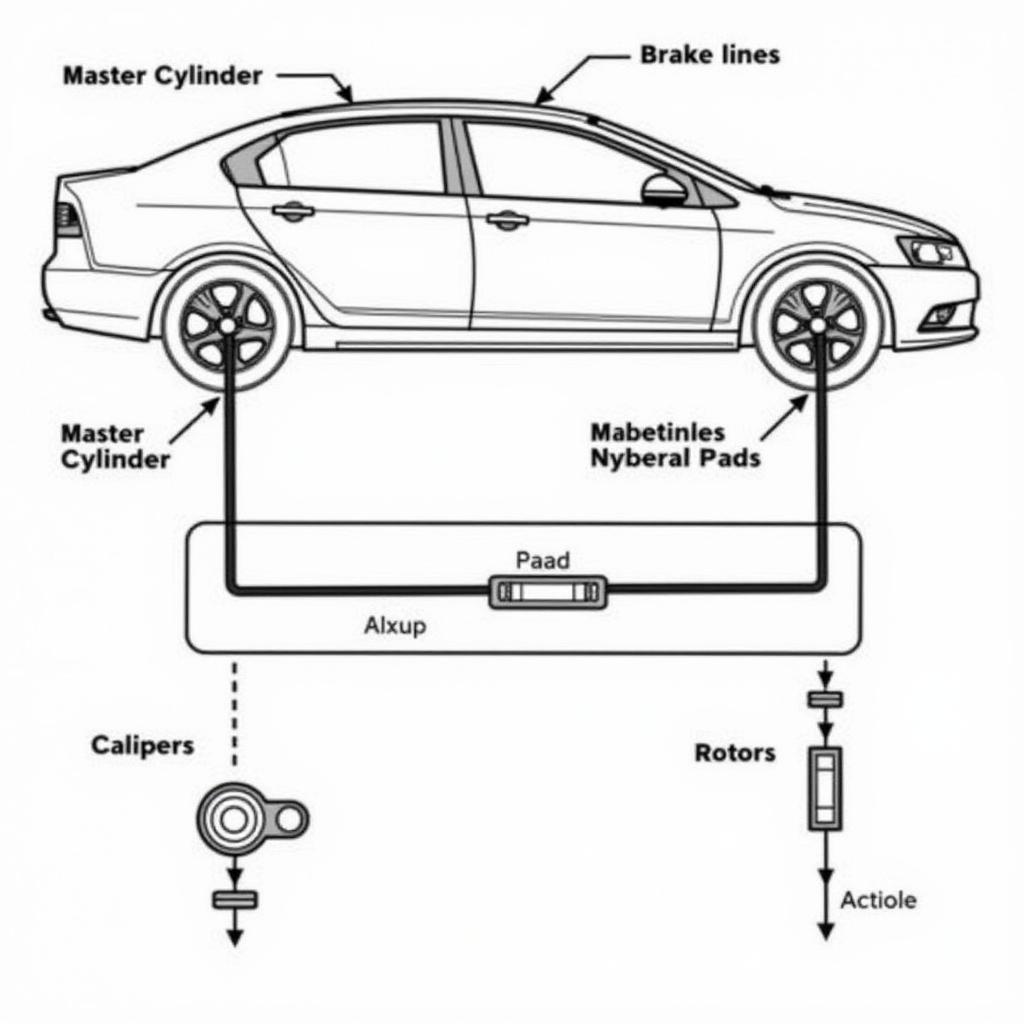Seeing a brake pad warning light on your dashboard, especially during your MOT in 2019, can be a nerve-wracking experience. It usually means one thing: it’s time to pay attention to your car’s braking system. This article delves into the reasons behind this warning light, its implications on your MOT, and the steps you can take to rectify the issue.
Understanding Your Car’s Braking System and the Warning Light
Your car’s braking system is a complex network of components working together to ensure your safety on the road. At the heart of this system are your brake pads, responsible for generating the friction needed to slow down or stop your vehicle. Over time, these pads wear down naturally due to constant use.
The brake pad warning light is a crucial safety feature designed to alert you when the brake pads have worn down to a critical level, requiring immediate attention. Ignoring this warning can lead to further damage to the braking system and compromise your safety on the road.
Brake Pad Warning Light and MOT 2019: What’s the Connection?
The MOT (Ministry of Transport) test is an annual check in the UK to ensure vehicles meet road safety and environmental standards. Your car’s braking system is a crucial aspect of the MOT, and any faults, including worn-out brake pads, can lead to a failed test.
In 2019, the MOT underwent some changes, but the focus on efficient brakes remained paramount. If your brake pad warning light illuminates during your MOT, it’s highly likely your vehicle will fail the test. This is because the minimum brake pad thickness requirement ensures adequate braking performance and safety on the road.
Common Causes of a Brake Pad Warning Light
Several factors can trigger the brake pad warning light, with worn-out brake pads being the most common culprit. However, other potential causes include:
- Worn brake pad sensor: Most modern vehicles have a wear sensor embedded in the brake pads. This sensor, often a small piece of metal, comes into contact with the brake rotor when the pads wear down, completing a circuit and illuminating the warning light.
- Low brake fluid: Brake fluid is the lifeblood of your car’s braking system, transmitting the force applied to the brake pedal to the wheels. A leak in the brake lines or a severely low fluid level can trigger the warning light.
- Faulty ABS system: The Anti-lock Braking System (ABS) prevents wheel lockup during hard braking. A malfunctioning ABS system can sometimes trigger the brake pad warning light, though this is less common.
Diagnosing the Problem: What to Do When Your Brake Pad Warning Light Turns On
“Ignoring a brake pad warning light is like playing Russian roulette with your safety,” says John Miller, a senior automotive technician with over 20 years of experience. “It’s crucial to address the issue immediately to avoid potentially dangerous situations on the road.”
If your brake pad warning light turns on, take the following steps:
- Check your brake fluid level: Locate the brake fluid reservoir under the hood and check the fluid level. If it’s significantly low, there might be a leak, and you should consult a mechanic immediately.
- Inspect your brake pads: If you’re comfortable doing so, you can visually inspect your brake pads for wear. Look through the spaces between the wheel spokes to check the pad thickness. If they appear thin or you see metal-on-metal contact, it’s time for a replacement.
- Seek professional help: If you’re unsure about the cause of the warning light or uncomfortable inspecting the brakes yourself, it’s always best to err on the side of caution and consult a qualified mechanic. They have the expertise and tools to diagnose the problem accurately and recommend the necessary repairs.
Addressing the Issue: Brake Pad Replacement and Other Solutions
In most cases, replacing the worn-out brake pads will resolve the issue and turn off the warning light. However, depending on the diagnosis, other repairs might be necessary, such as:
- Replacing the brake pad sensors: If the sensors are faulty, they will need to be replaced along with the brake pads.
- Repairing brake fluid leaks: Leaky brake lines or components will need to be repaired or replaced to ensure the braking system functions correctly.
- Addressing ABS system faults: If the ABS system is malfunctioning, it will require diagnosis and repair by a qualified technician.
Preventing Future Issues: Brake Maintenance Tips
Preventing brake problems is always better than dealing with them after they arise. Here are some tips to keep your braking system in optimal condition:
- Regular brake inspections: Have your brakes inspected by a qualified mechanic at least once a year or as recommended in your car’s owner’s manual.
- Adhere to a maintenance schedule: Follow the manufacturer’s recommended maintenance schedule for brake fluid flushes and brake pad replacements.
- Adopt smooth driving habits: Avoid hard braking and accelerating whenever possible to minimize wear and tear on your brakes.
- Pay attention to unusual noises: Be alert for any unusual noises, such as squealing, grinding, or vibrations when applying the brakes, as these can indicate a problem.
Conclusion
Ignoring a brake pad warning light, particularly in the context of an MOT like the one in 2019, can have serious consequences. Remember, your car’s braking system is crucial for your safety and that of other road users. Regular maintenance, prompt attention to warning signs, and timely repairs are essential to keep you safe on the road.
For more information on specific warning messages related to Mazda vehicles, you can check out our detailed guides on Mazda 2019 brake warning screen and Mazda 2019 brake safety warning.

